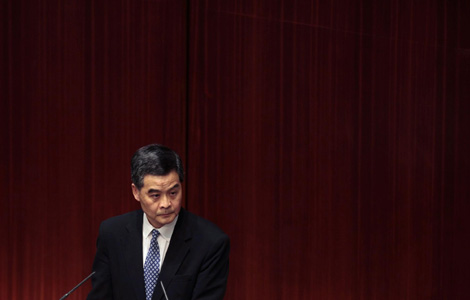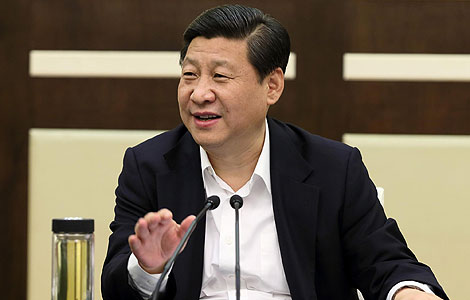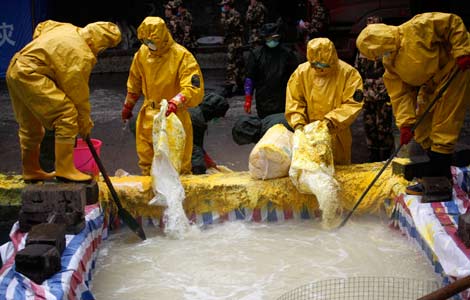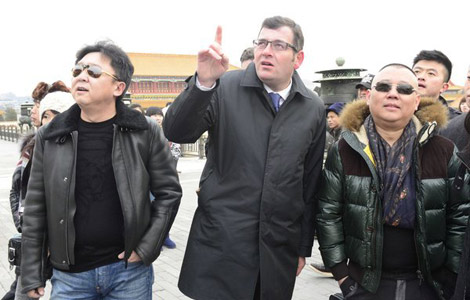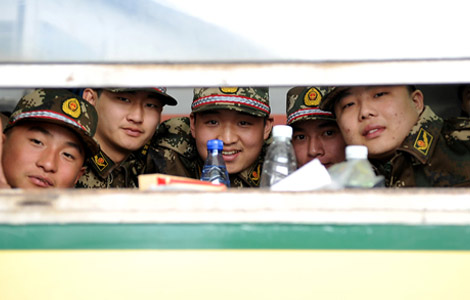
It's half heaven and half hell.
That's how many Chinese investors say they more or less feel about their work to tap mining and energy resources in Peru.
Kong Aimin, director of the mining company Shougang Hierro Peru SAA, has been in Peru ever since Shougang Group bought an iron ore company there in 1992.
Shougang was the first Chinese company to make a foray into the mining industry abroad. The company has the permanent right to exploit the Marcona iron ore mine, which occupies 670 square kilometers in Peru's Ica region.
The iron ore pulled out of the ground there is of a very high grade. The local transport system is convenient. And the city sees scarcely any rain at all during the year, making the climate advantageous for mining.
All these conditions may sound admirable, but Kong's life in Peru has by no means been easy. His time in the country has seen him beset by labor and safety issues.
"Since the first day I was in Peru, strikes have been breaking out almost continuously," Kong said. "We knew they would never end, and we'd just have to get used to it.
"More than 90 percent of my work and time has been spent on issues related to workers, the community and the local government."
During October, Kong found himself bending over backwards to deal with a strike organized by Shougang Hierro employees demanding higher wages and greater benefits.
It was the second strike Shougang had to deal with this year. The previous one lasted more than 20 days. This time it was even longer — almost a month.
Kong responded by going back and forth among the labor union involved in the conflict, the Peruvian government and legal institutions, trying to negotiate a deal.
He said he knew he could only hope to bring the dispute to a close as quickly as possible.
"We never expected that the strikes would end if we didn't concede anything," said Kong.
This time, as happened in many of the previous disputes, Shougang agreed to pay higher wages.
Kong and Shougang's experiences illustrate some of the difficulties confronting Chinese enterprises that are exploring for mining and energy resources in Peru.
"For those that want to come to Peru, Shougang's case is really worth learning about," said Gao Jinbao, Chinese commercial counselor to Peru. "They have to get fully prepared for it before they take any action."
Wu Jian, vice-president of Junefield Mineral Resources Holdings Ltd, a Lima-based mining developer, said "many Chinese companies didn't become acquainted with the market and culture before they came here."
"They had no idea that this Latin American country is really quite different from China in many ways: in its language, the government's role in the economy and its laws, regulations and culture."
Peru is one of the world's top 12 mining countries, possessing rich reserves of copper, zinc, silver, iron ore and oil. Estimates suggest that 80 percent of Peruvian territory contains abundant mining resources. The country is the world's second-largest producer of copper, and its output of the metal is expected to increase by 75 percent by 2015. It also contains large amounts of oil, natural gas and valuable metals.
This has proved attractive to a number of companies from around the world.
Seeking win-win business
So far, more than 80 Chinese companies run businesses in Peru, and the majority of them involve energy and mining resources. According to statistics from the Chinese embassy in Peru, China's cumulative investment in the country reached $3 billion by the end of 2011.
Besides Shougang Hierro, other investments by Chinese enterprises include the Aluminum Corp of China's Toromocho copper mine in the country's Junin region, which the company is expected to spend close to $4 billion on, and China Minmetals Corp's $2.5 billion El Galeno copper and gold project in the city of Cajamarca.
"In Peru, many companies have had to cope with labor issues like the ones we've experienced and will have to continue to do as long as they have become big or expect to expand," said Kong.
David Dai, vice-president of Mineral Chinalco Peru SA, agreed.
"Peru is a special country," Dai said. "Whatever we do, and in whatever way we operate, we always feel pressures and doubts."
In 2007, Chinalco announced plans to spend $860 million to buy Peru Copper Inc. The deal gave the company a mine containing more than 12 million tons of copper in Toromocho.
The copper project is the largest Chinalco has been involved in overseas.
The Toromocho mine is expected to open in late 2013, operate for 40 years and produce 250,000 tons of copper a year. If those predictions come true, the amount mined will be equal to almost a quarter of Peru's output last year and a fourth of China's annual output.
"We are confident about the returns on our investment," Dai said.
A Peruvian town occupies the same site as the copper mine. To move it, Chinalco is building a new city, complete with paved roads and houses. Those who live there will have access to amenities that they currently lack, such as modern water, sewage and electrical systems.
"It's going to cost a lot," Dai said. "The new $50 million town will be the biggest privately financed social project in Peru's mining history."
As China's mining and energy companies move faster to expand into overseas markets, foreign countries are increasingly invoking the need to protect their national security as grounds for barring them.
US political resistance, for example, helped to derail China National Offshore Oil Corp's 2005 attempt to acquire the California-based Unocal Corp. This year, the oil company's $18 billion bid to take over the Canada-based oil and gas company Nexen Inc was delayed by months before being approved by the Canadian government on Friday. Even so, the deal continues to stir controversy in the United States, where less than 10 percent of Nexen's assets are located.
Meanwhile, Chinese companies have moved much slower than their Western rivals to exploit mines in places such as Africa and Latin America.
And even when they win bids for the right to develop mines, operating a business in foreign countries has proved harder than many expected, as Shougang and Chinalco have found out in Peru.
Despite showing moderate growth in the past few years, the Peruvian economy continues to be fragile, and there remains a large disparity in incomes. Such conditions could easily lead to public protests.
Labor unions tend to be strong in Peru and have proved aggressive in using strikes and similar tactics to press their demands on companies.
But, "because of the electoral system, the government always unites with labor unions to put pressure on us", Kong said.
Rising to challenges
Despite the nearly constant presence of labor tensions, few Chinese companies, especially those in the mining industry, are eager to leave Peru.
By the end of September, the Peruvian economy had shown 37 consecutive months of growth.
The oil and gas company PetroChina Co Ltd has two oil management projects in Peru. They were started in 1993 and 2003, and the company has only needed from four to five years to recoup its investment in them, said Zhang Xuan, vice-president of SAPET Development Peru Inc — one of the two companies PetroChina has in Peru.
"Doing business far away from China is a bit hard, but we are here now," Zhang said. "Generally speaking, things are going well."
The company's Peruvian projects are due to expire in 2015. PetroChina is now planning to either seek to have that date pushed back or to enter into negotiations with the Peruvian government to bid for the projects again.
Beyond that, "we are also looking for new opportunities to sustain our expansion here", Zhang said.
Fulfilling those plans won't necessarily be easy.
"We have to meet the new demands that the local government and community have on a wide range of issues: politics, rules and regulations, finance and environmental protection," Zhang said.
Despite Chinese companies' complaints about local business conditions, Peru remains fairly attractive to investors from around the world.
A recent report by the investment and risk management service provider BlackRock Inc suggested Peru is the second-most-common destination for foreign direct investment into Latin America.
From January to June, Peru's FDI increased by 31 percent year-on-year to $5.44 billion, which was a much larger amount than that for the whole Latin American region during the same period. In 2011, Peru attracted $8.2 billion worth of FDI.
"Like us, companies from many other foreign countries are also facing problems here," Gao said.
"So we have to adjust to the conditions, and that leaves Chinese companies such as this one a lot of room for improvement."
While Chinese companies are investing more overseas, the Chinese government is reminding them to be responsible. In May, various central government departments released guidelines calling on Chinese companies to fulfill their social responsibilities and provide benefits to communities abroad.
Carlos Posada Ugaz, Peruvian vice-minister of Foreign Trade, defended Peru's investment climate.
"We open our arms to all Chinese companies," he said. "Peru's FDI policy aims to protect laborers' interests and companies' benefits as well."
Ugaz called on Chinese companies to "do more to create social welfare and create more benefits in the local community in Peru, on top of reaping profits in the country, such as building more hospitals, education centers and some other infrastructure facilities.
"Chinalco sets a good example for Chinese companies."
So far, Shougang Hierro has spent $45 million on more than 10 environmental protection projects related to wastewater, dust and atmospheric pollution, and provided $5 million in donations. The company has spent $7 million on infrastructure in Peru, and is arranging to have another $6 million go to the same purpose.
Contact the writer at dingqingfen@chinadaily.com.cn
